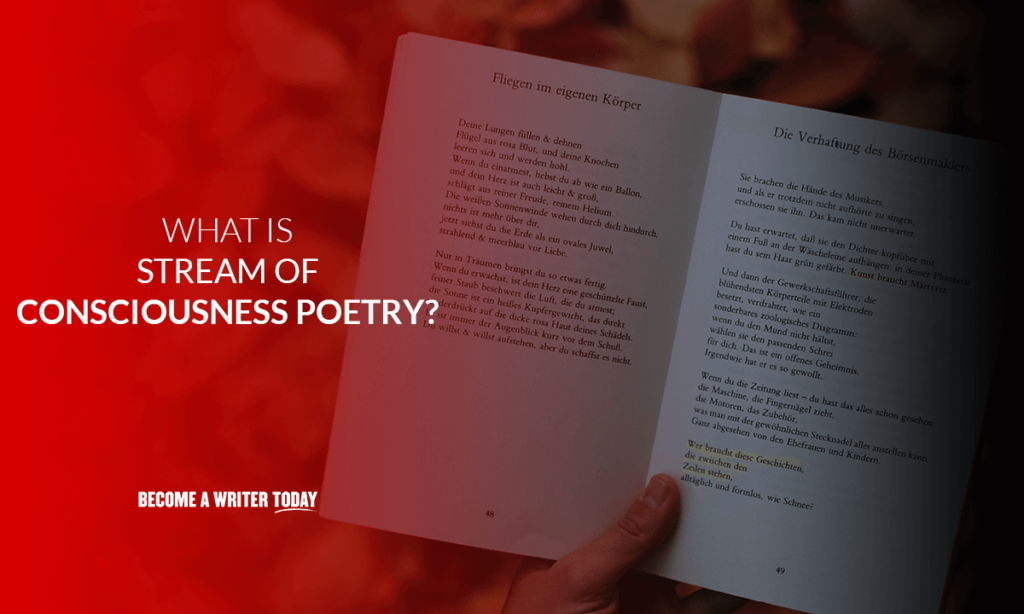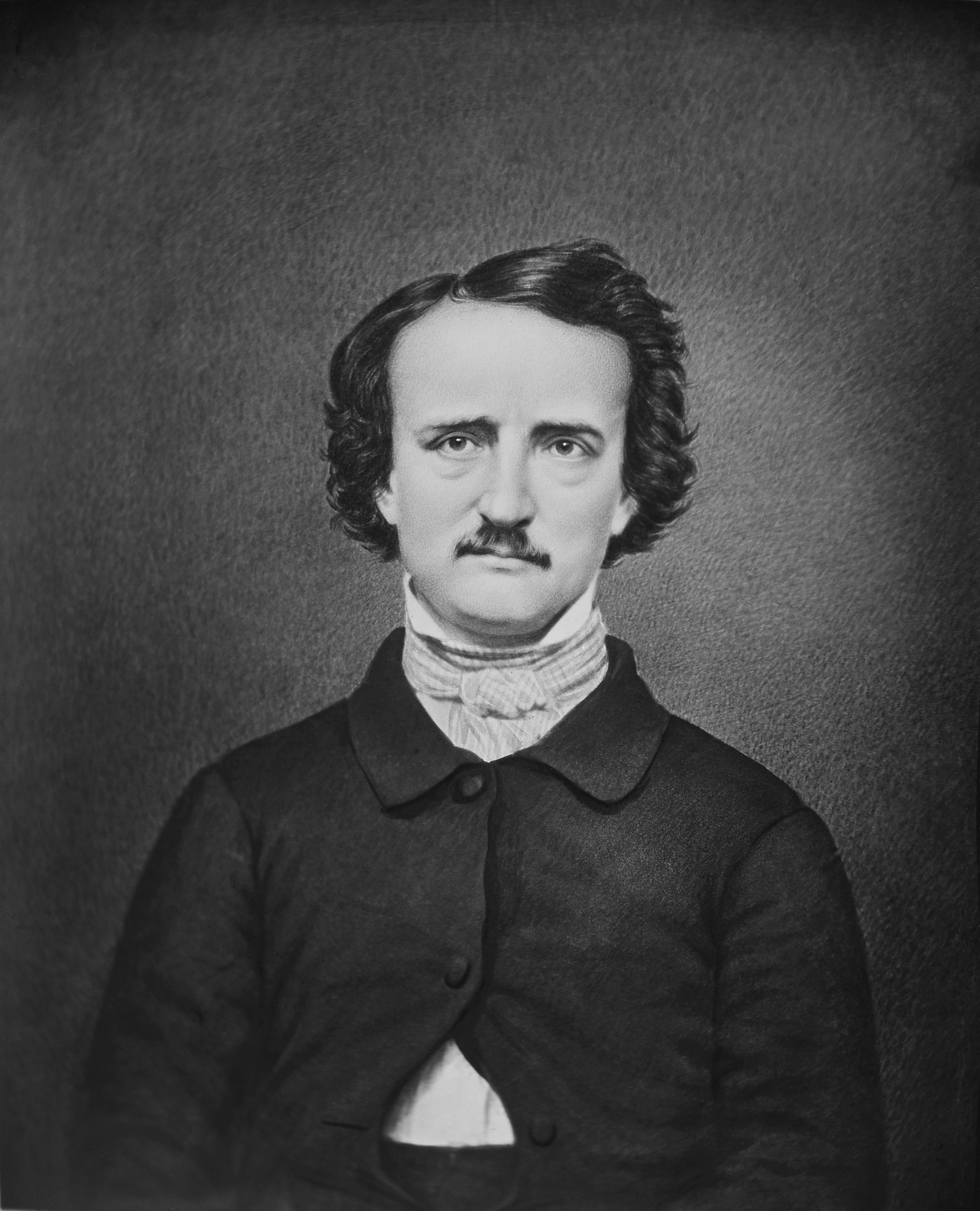Stream of Consciousness poetry gives insight into what a narrator is thinking with free writing of a character’s internal thoughts.
Stream of consciousness is a writing style that allows the author to show the character’s thoughts unfiltered, without attention to grammar and punctuation. By writing out the interior monologue, the author gives insight into the thoughts and desires of the character.
The term stream of consciousness originates with psychologist William James who first used the term in his 1890 work The Principles of Psychology. As a literary device, it gained popularity with the writing of authors like Virginia Woolf, author of Mrs. Dalloway, and James Joyce, author of Ulysses.
These novels are great examples of stream of consciousness writing, but stream of consciousness poetry is something else entirely. Stream of consciousness poems are written in poetic form with a lack of punctuation and often the first-person perspective. Poems written using this literary technique do not usually rhyme, but focus rather on getting the character’s thoughts on paper.
Stream Of Consciousness Poetry Examples

Stream of consciousness is often used in short stories and novels, but it also shows up in poetry. Many poets employ the use of stream of consciousness in their poetry. To understand this style of writing and the syntax that comes from it, take a look at these well-known poems.
“The Love Song of J. Alfred Prufrock” by T.S. Eliot
In this poem, Eliot shows the internal monologue of his main character, Prufrock, as he tries to escape his thoughts. Some have said that this is the representation of modern man, but regardless of Eliot’s meaning, it is a clear example of the stream of consciousness narrative style. To learn more about poems and poetry, read our guide to what is a sonnet in poetry. You can also search for more poems using our search bar.
“Let us go then, you and I,
When the evening is spread out against the sky
Like a patient etherized upon a table;
Let us go, through certain half-deserted streets,
The muttering retreats
Of restless nights in one-night cheap hotels
And sawdust restaurants with oyster-shells:
Streets that follow like a tedious argument
Of insidious intent
To lead you to an overwhelming question …
Oh, do not ask, “What is it?”
Let us go and make our visit.In the room the women come and go
Talking of Michelangelo.The yellow fog that rubs its back upon the window-panes,
The yellow smoke that rubs its muzzle on the window-panes,
Licked its tongue into the corners of the evening,
Lingered upon the pools that stand in drains,
Let fall upon its back the soot that falls from chimneys,
Slipped by the terrace, made a sudden leap,
And seeing that it was a soft October night,
Curled once about the house, and fell asleep.”
“The Tell-Tale Heart” by Edgar Allan Poe

In “The Tell-Tale Heart,” Poe uses the stream of consciousness narrative technique to show the internal thoughts of his narrator. As the poem develops, this insight into the character’s thought processes reveals that he is, in fact, quite mad. The ever-beating heart is a picture of the narrator’s guilty conscience.
“Was it possible they heard not? Almighty God! — no, no! They heard! — they suspected! — they knew! — they were making a mockery of my horror! — this I thought, and this I think. But anything was better than this agony! Anything was more tolerable than this derision! I could bear those hypocritical smiles no longer! I felt that I must scream or die! — and now — again! — hark! louder! louder! louder! louder! —
“Villains!” I shrieked, “dissemble no more! I admit the deed! — tear up the planks! — here, here! — it is the beating of his hideous heart!”
“A Boy in Church” by Robert Graves
Sitting in church listening to a preacher while trying to occupy a young mind is something many people can relate to, certainly if they were churchgoers in their youth. This experience, and the thoughts behind it, are what Robert Graves captures in “A Boy in Church.” When reading this poem, the reader can practically picture the squirming young man as he sits, probably with an uncomfortable pair of shoes on his feet, waiting for the service to get over while staring out the window and watching the trees blowing in the wind.
“‘Gabble-gabble, . . . brethren, . . . gabble-gabble!’
My window frames forest and heather.
I hardly hear the tuneful babble,
Not knowing nor much caring whether
The text is praise or exhortation,
Prayer or thanksgiving, or damnation.
Outside it blows wetter and wetter,
The tossing trees never stay still.
I shift my elbows to catch better
The full round sweep of heathered hill.
The tortured copse bends to and fro
In silence like a shadow-show.”
Other Stream of Consciousness Writers to Know
Stream of consciousness narratives often shows up not in poems but rather in novels. Some of the most famous stream of consciousness novel writers write in a poetic form, but their works are not true poetry. To understand the literary device, however, you should also understand these writers.
Ulysses by James Joyce
Ulysses, an often banned novel by James Joyce, follows a single day in the life of Leopold Bloom, an Irish man who explores the streets of Dublin. This work is an excellent example of early 20th Century modernism, and Joyce’s use of humor, allusion, puns, and parodies makes it one of the greatest works in literary history. It is also an excellent example of stream of consciousness.
“Heavenly weather really. If life was always like that. Cricket weather. Sit around under sunshades. Over after over. Out. They can’t play it here. Duck for six wickets. Still Captain Culler broke a window in the Kildare street club with a slog to square leg. Donnybrook fair more in their line. And the skulls we were a-cracking when M’Carthy took the floor. Heatwave. Won’t last. Always passing, the stream of life, which in the stream of life we trace is dearer than them all.”
On the Road by Jack Kerouac
American writer Jack Kerouac blended his voice to the stream of consciousness world with his 1957 book On the Road. This book shows the author’s thoughts as he drives across the country with his friends. Literary criticism regularly ranks it as one of the top English-language novels of modern times.
“Sal, we gotta go and never stop going ’till we get there.’
‘Where we going, man?’
‘I don’t know but we gotta go.”
To the Lighthouse by Virginia Woolf
In 1927, Virginia Woolf published To the Lighthouse. This stream of consciousness novel watches as the Ramsay family as multiple visits to the Isle of Skye in Scotland. This work makes the stream of consciousness style more accessible to less astute readers, as it follows the point of view of three different family members as time passes in their lives. If you are interested in learning more about poetry, read our round-up of words for poets!
“What is the meaning of life? That was all- a simple question; one that tended to close in on one with years, the great revelation had never come. The great revelation perhaps never did come. Instead, there were little daily miracles, illuminations, matches struck unexpectedly in the dark; here was one.”
A Final Word on Stream of Consciousness Poetry
Stream of consciousness poetry gives insight into a narrator’s thoughts about their day or their life. It can show profound truths about human psychology, and the lack of punctuation makes this writing style perfect for poetic verse.
As you learn to love poetry, consider how many poems are really stream-of-consciousness writing. You will find that this technique shows up more often than you realize when you start looking for it.
FAQs About Stream of Consciousness Poetry
What is stream of consciousness poetry?
Stream of consciousness poetry is poetry that shows the internal thoughts or dialogue of the narrator.
What are some examples of stream-of-consciousness poetry?
Three examples of stream of consciousness poetry include:
1. “The Love Song of J. Alfred Prufrock” by T.S. Eliot
2. “The Tell-Tale Heart” by Edgar Allan Poe
“3. A Boy in Church” by Rober Graves